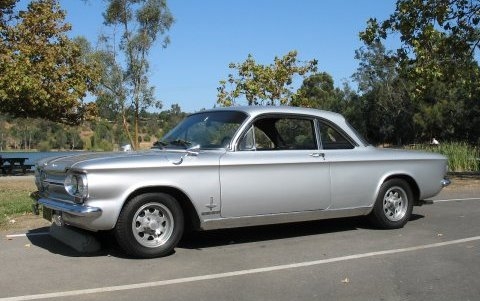 On a cold winter’s day in January of my fourteenth year, everyone in the family had gone shopping, leaving my younger brother, Steve, and I home alone. The bright sun ricocheted off the highly polished luster of my brother Tom’s silver Chevrolet Corvair as it rested quietly in our driveway. It was 1964, and Tom had just returned from the Marine Corps.
On a cold winter’s day in January of my fourteenth year, everyone in the family had gone shopping, leaving my younger brother, Steve, and I home alone. The bright sun ricocheted off the highly polished luster of my brother Tom’s silver Chevrolet Corvair as it rested quietly in our driveway. It was 1964, and Tom had just returned from the Marine Corps.
The Corvair was a rear-engine compact car that was later dropped from production largely due to the research of one man, Ralph Nader. His book “Unsafe at Any Speed” exposed the dangerous handling characteristics of the Corvair. It turned out the car tended to spin out easily, leaving the driver looking in the wrong direction—which can be very confusing at highway speeds.
I knew the keys were in it (we never took the keys out of our cars back then) and it looked like a beautiful day for a drive. Besides, what could it hurt? A quick trip around the countryside, park it carefully back in the same spot, and none would be the wiser. Sure, I was only 14, but this was before Driver’s Education was required and my older brothers, who shared my love for automotives, had often allowed me to drive their cars on our country roads. I was convinced of two things: I was mature beyond my years and I was a great driver!
Steve and I hopped in, I hit the key and its supercharged engine fired to life. Seat belts were not yet standard equipment; however, Tom had installed aftermarket seat belts to give his sporty little car a racy flair. And so Steve and I, in order to ensure the complete race car experience, took time to buckle our lap belts and cinched them tight. I slid the four speed shifter into first and headed out on the highway, looking for adventure and whatever came our way.
Most of the roads in our area were gravel. We approached a gentle rise, which I had traversed hundreds of times with other drivers—I had memorized how the hill broke over into an even-arched left hand curve. My fourteen-year-old mind snapped into fantasy mode as I down shifted and floored the accelerator, apparently believing I was able to slide the car through the corner under power, just like in the movies.
When things go wrong, they go wrong quickly, and it becomes impossible to mentally catalogue what happened when. I do remember a deep thud and an eerie screech, as if a dog were being tortured. Then suddenly the Corvair slammed back to the ground with a bang!—her interior filled with dust and broken glass. I looked at Steve and said, “Are you OK!” He slowly nodded yes.
My only thought was to get the car back home and try to clean it up. I grabbed for the key to restart the engine. Steve, who was now looking out the hole where the back glass used to be, said matter-of-factly, “I don’t think it’s gonna start… the engine’s laying back there on the road.”
Sure enough, we had spun out and hit a bank with the tail end of Tom’s spotless new car with such force that it ripped the engine and the rear wheels completely free of the chassis. It was later determined from the markings that we had rolled up and onto the top of that high bank, slid on the roof for over fifty feet, and then slammed back down onto the road, landing on the two remaining wheels.
Steve was right: it didn’t start again… ever.
I’m not proud of my actions. But it is a perfect example of God’s protection and mercy in spite of my incredibly poor judgment.
King David recognized God’s preserving mercy when he wrote:
“When I was desperate, I called out, and God got me out of a tight spot. God’s angel sets up a circle of protection around us while we pray.” Psalm 34:6-7
I’m sure you realize there have been times when God has bailed you out, just as He has me. I’d encourage you to take a moment and thank Him for His Grace. In theology, this is known as God’s Prevenient Grace. Simply put, God goes ahead of us, protecting and providing for us in ways we could never imagine.
Read Ron’s column, Simple Faith, each Saturday on the Faith Page (page 3) of the Lancaster Eagle Gazette, or visit www.lancastereaglegazette.com.
